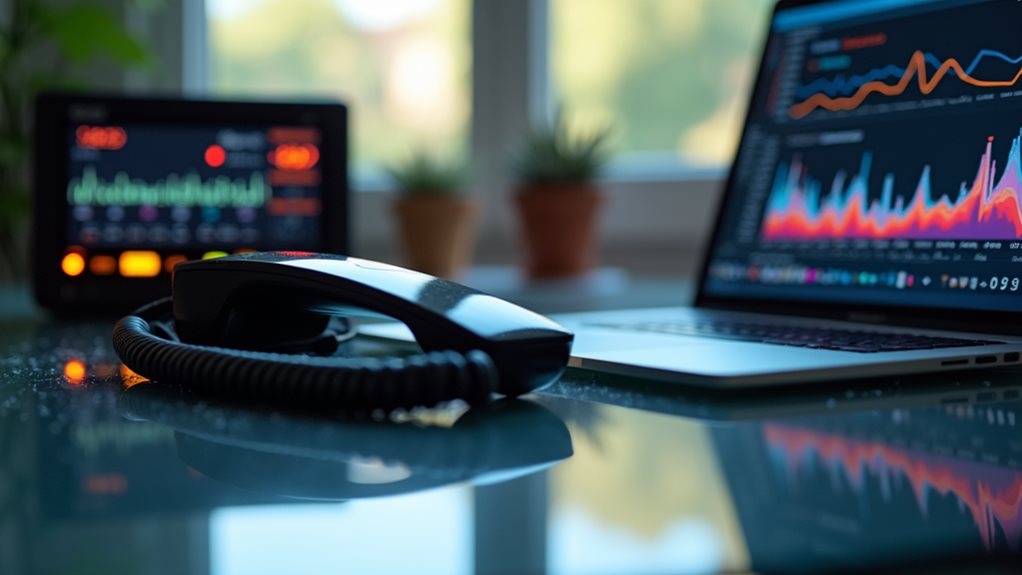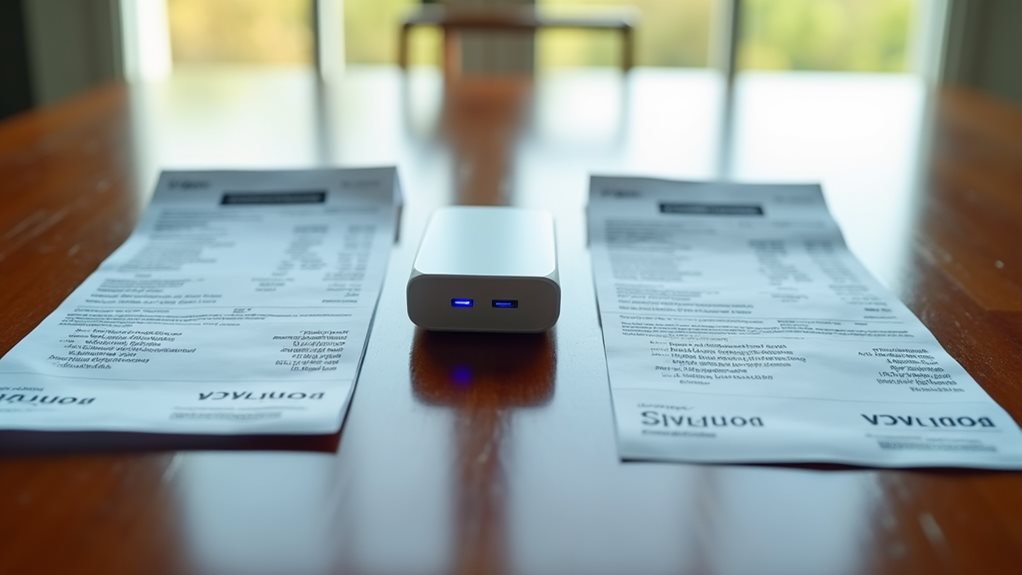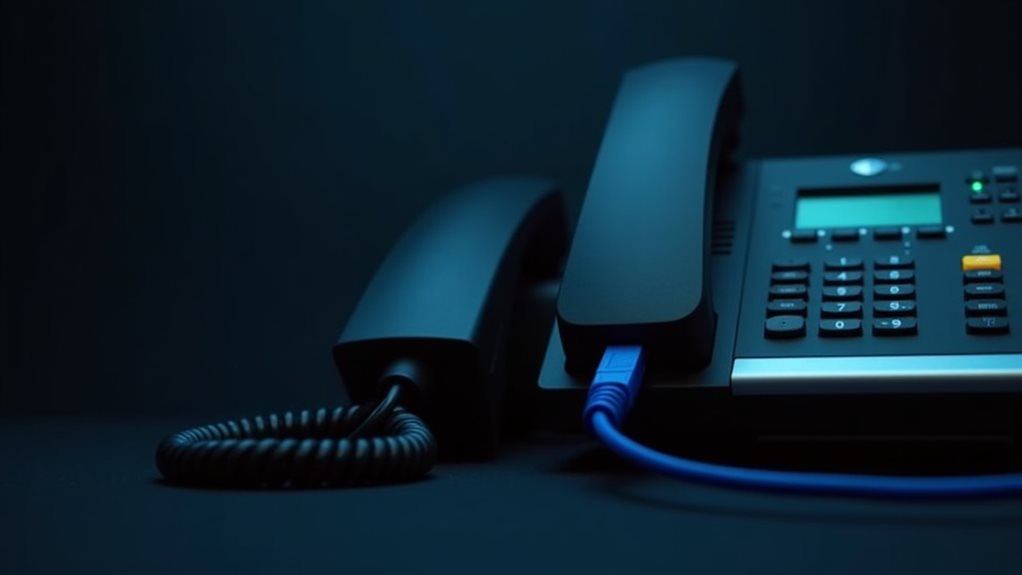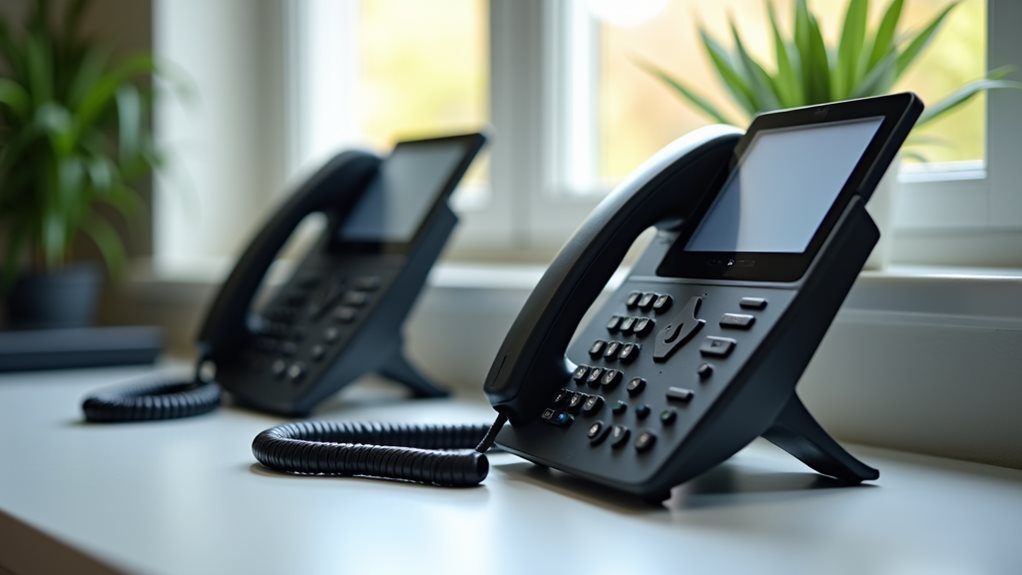You can identify a VoIP phone line through several key indicators. First, check if your phone connects to an internet router or adapter (ATA) instead of a traditional phone jack. Look for RJ-45 Ethernet cables rather than standard RJ-11 phone cords. VoIP systems also require a consistent internet connection to function, so if your phone stops working when your internet goes down, you're likely using VoIP. Additionally, examine your monthly bill for internet-based calling features and rates typically ranging from $25-40 per line. Understanding these technical aspects will help you reveal more insights about your phone system's infrastructure.
Understanding VoIP Phone Lines
The essence of VoIP (Voice over Internet Protocol) phone lines lies in their modern approach to voice communication. Unlike traditional phone systems, VoIP transforms your voice into digital data, sending it through the internet rather than copper wires. You'll find that this technology represents a significant shift in how we connect and communicate in today's digital age.
When you're considering VoIP advantages, you'll appreciate the remarkable flexibility and cost-effectiveness it offers. You can use your phone number anywhere there's an internet connection, and you'll have access to advanced features like call forwarding, voicemail, and conference calling. The technology can help businesses reduce their communication costs by up to 60% over traditional phone services. Additionally, VoIP systems offer features such as video conferencing and instant messaging, which enhance interaction within teams. The HD call quality, thanks to sophisticated sound compression, guarantees your conversations remain crystal clear. Many providers offer number porting to help you keep your existing phone number when switching to VoIP.
However, it's important to understand VoIP limitations. You'll need a reliable high-speed internet connection for peak performance, as your call quality depends on your internet stability. Quality of service protocols prioritize voice data for reliability, leading to uninterrupted communication.
While you'll enjoy the convenience of using various devices – from computers to tablets – you'll want to make sure your internet service can handle the data demands.
Despite these considerations, you'll find that VoIP's scalability and feature-rich nature make it an increasingly popular choice for modern communication needs.
Physical Equipment and Setup
To identify a VoIP phone line, you'll want to start by examining your connection box and any adapters between your phone and the wall socket.
The presence of an Ethernet cable running to your phone or an ATA (Analog Telephone Adapter) is a clear indicator that you're using VoIP rather than traditional phone service. High-speed internet is essential for VoIP systems to function properly, as it ensures clear and stable call quality.
You can also check the device ports on your phone or adapter—VoIP setups typically have RJ-45 (Ethernet) ports instead of the standard RJ-11 telephone jacks found in conventional phone systems. Many modern VoIP systems utilize Power over Ethernet to eliminate the need for separate power adapters.
Adapter and Cable Setup
Setting up VoIP service requires specific physical equipment and proper cable connections to work effectively.
You'll need to start by selecting compatible adapter types, such as an ATA (Analog Telephone Adapter) or VoIP phone, and ensuring you have the right cable specifications, typically Cat 5e or Cat 6 Ethernet cables for ideal performance. Moreover, you should select a provider that ensures high-quality, uninterrupted voice calls, which is essential for a reliable service.
To connect your system, you'll need to link your VoIP adapter to your router using an Ethernet cable, while traditional phones connect to the adapter through an RJ11 port. Single and dual FXS ports are available depending on how many analog phones you need to connect.
If you're using existing phone jacks, you'll want to verify they're properly wired using the standard red and green telephone wiring code. When your phone jacks aren't conveniently located near your router, you might need to run new cables. Approximately 40% of businesses now use this setup for their communication needs.
Your setup's success depends on having a high-speed internet connection, preferably fiber optic, and a compatible router.
Once you've connected everything, you'll configure your adapter through its web interface using credentials from your VoIP provider.
Don't forget to make a test call to confirm your system's working correctly before relying on it for regular use.
Device Port Configuration
Proper device port configuration forms the backbone of any VoIP phone system. When you're setting up your VoIP devices, you'll need to guarantee your router and switch ports are correctly configured to support voice traffic while maintaining network security.
It's essential to verify device compatibility before proceeding with any configurations. The default security policy typically blocks all traffic, requiring specific port configurations for VoIP functionality.
Your switch ports should be set up in access mode with a dedicated voice VLAN, which helps prioritize your voice traffic and improve call quality. You'll want to enable CDP (Cisco Discovery Protocol) on your ports, as it allows your VoIP phones to automatically receive important configuration information. Additionally, effective VLAN segmentation can further enhance network efficiency by reducing interference among different traffic types. The switch can provide Power over Ethernet to connected VoIP phones.
Don't forget to configure spanning-tree portfast and MLS QoS trust settings to optimize performance.
For your router, you'll need to set up port forwarding for SIP (port 5060) and RTP (ports 10000-20000) to guarantee your VoIP traffic can flow smoothly through your firewall.
Check that your ethernet connections are properly configured and that your network can handle the bandwidth requirements for voice traffic. If you're using a managed switch, make sure QoS settings are properly configured to prioritize voice packets over regular data traffic, allowing for minimal latency and optimal call quality during peak usage.
Connection Box Assessment
Examining your connection box setup provides clear physical evidence of whether you're using VoIP service. When performing a connection box analysis, you'll want to identify specific components that indicate VoIP connectivity. Your setup will typically include a modem, router, and possibly an ATA adapter if you're using traditional phones with a VoIP system. Since VoIP systems are dependent on power, they require backup solutions during outages. Also, quality of service (QoS) settings can significantly improve your call clarity and reliability.
Running a capacity assessment test can help ensure your network infrastructure can handle VoIP traffic demands effectively. To guarantee equipment compatibility and proper identification, check these key elements:
- Look for an Ethernet (RJ-45) connection between your phone equipment and router, which is a strong indicator of VoIP service.
- Identify whether there's an ATA or VoIP adapter present, which converts analog signals to digital for VoIP systems.
- Verify if your phone service connects through your internet modem rather than traditional telephone wiring.
Your connection box configuration tells an important story about your phone service type. If you notice multiple Ethernet cables, a router handling network traffic, and broadband internet equipment, you're likely using VoIP.
Remember that modern VoIP setups require stable internet connectivity, so you'll always find networking equipment as part of the installation, unlike traditional POTS lines that operate independently.
Call Quality and Performance

With VoIP phone lines, call quality depends heavily on your internet connection and network performance. You'll notice that VoIP calls can sound crystal clear one moment and garbled the next, which is why monitoring call metrics and performing regular quality assessments is essential for maintaining reliable service.
When you're using VoIP, you'll want to pay attention to several key indicators that might reveal whether you're experiencing typical VoIP behavior. Listen for common issues like echoes, delays in conversation, or choppy audio – these are telltale signs of VoIP service.
You can also check your call quality by making test calls at different times of the day, as network congestion often affects VoIP performance. Regularly monitoring network performance metrics can help you identify and troubleshoot issues that impact call quality.
If you're experiencing consistent issues, you'll benefit from checking your internet speed regularly and ensuring it meets the minimum requirement of 3-5 Mbps.
Remember that your VoIP quality might also be affected by other devices sharing your network connection. Consider using Quality of Service settings on your router to prioritize voice traffic and maintain clear, consistent calls throughout your conversations.
Internet Connection Requirements
While call quality issues often point to VoIP service, understanding your internet connection requirements will help you confirm if you're using VoIP and guarantee peak performance.
Your bandwidth calculation starts with knowing that each VoIP call needs about 90-100 kbps for clear communication, and codec impact varies depending on the type you're using.
To determine if your internet connection supports VoIP, consider these essential factors:
- Calculate your peak call volume by multiplying the maximum number of simultaneous calls by 0.2 Mbps.
- Test your current internet speed using a VoIP-specific network test to verify both upload and download capabilities.
- Factor in additional bandwidth needs for other online activities like web browsing and file sharing.
If you're running ten concurrent calls, you'll need approximately 1-1.25 Mbps of dedicated bandwidth.
Remember that different codecs affect your requirements differently – G.711 needs about 98.92 kbps per call, while G.729 uses only 42.92 kbps. Additionally, poor call quality metrics such as jitter and latency can significantly affect your VoIP experience.
When your internet connection consistently meets these specifications, it's a strong indicator that your line is VoIP-ready or already using VoIP technology.
Costs and Billing Patterns

Three key billing patterns can help you identify if your phone line is VoIP. You'll notice that VoIP systems typically offer automated invoicing, real-time usage tracking, and subscription-based billing – features that aren't commonly found with traditional phone lines.
These patterns contribute to improved billing efficiency and help you manage your communications more effectively.
When you're examining cost comparisons between VoIP and traditional phone systems, you'll find that VoIP generally runs between $25 to $40 per month per line. If you're seeing these price points on your bill, along with flexible pricing models like per-minute billing or tiered pricing, you're likely using a VoIP system.
Additionally, if your bill includes charges for features like call recording or equipment rentals, that's another strong indicator of VoIP service.
You can also look for multi-layer charges on your bill that reflect usage-based pricing – a common characteristic of VoIP systems.
If you're part of a subscription plan with integrated payment processing and customizable billing reports, these modern billing features typically point to a VoIP setup rather than a traditional phone line. Furthermore, consider the possibility of portability and mobility as VoIP allows users to access their communication services from virtually anywhere.
Caller ID Features
Looking at your phone's caller ID features can quickly reveal whether you're using VoIP. Traditional phone lines display basic information, while VoIP systems offer enhanced caller ID customization and more detailed contact information.
You'll notice that VoIP caller ID uses digital packets transmitted through the internet, allowing for greater flexibility and features that aren't available with standard phone lines.
When examining your phone system, look for these telltale VoIP caller ID characteristics:
- Advanced display options showing business names, department information, or customized identifiers
- Real-time caller identification with detailed contact information beyond just numbers and basic names
- Flexible caller ID security settings that let you manage how your information appears to others
Your VoIP system's caller ID capabilities are managed through SIP protocols, which enable dynamic information sharing between devices. This sophisticated system enhances overall reliability and security through encrypted data exchange, ensuring your communications remain secure while allowing for advanced identification features.
If you're able to modify your outbound caller ID through an online portal or app, that's another clear indication you're using VoIP.
Additionally, you might notice that your caller ID information appears consistently across multiple devices, including desktop applications and mobile phones—a distinctive feature of VoIP systems.
Technical Characteristics and Settings

Since VoIP phones operate through internet protocols, their technical characteristics differ markedly from traditional landlines. You'll notice that your voice communications are converted into digital packets and transmitted through your internet connection rather than copper telephone lines. This fundamental difference means you're relying on your broadband connection for call quality and reliability.
When you're using a VoIP system, you'll find specific technical settings that aren't present in conventional phones. Your device requires proper SIP configuration to connect with your service provider, and you'll need to verify your network can handle voice data transmission.
If you're using a hardware-based VoIP phone, you'll see it has an ethernet port or WiFi capability instead of a traditional phone jack. For softphone users, you'll notice the application needs access to your device's microphone and speakers.
You can identify your VoIP line by checking your phone's network settings or looking for an administration interface. If you see options for entering SIP credentials or network configurations, you're definitely using a VoIP system.
Additionally, your phone will stop working if your internet connection fails, unlike traditional landlines. This reliance on the internet underscores the importance of network stability, which can significantly impact your VoIP call quality.
Frequently Asked Questions
Can I Keep My Existing Phone Number When Switching to Voip?
Yes, you can keep your existing number through number porting. Most VoIP providers offer this service, making your changeover seamless. Just check your number's VoIP compatibility and stay with your current provider until porting completes.
Will Voip Calls Work During a Power Outage?
Your VoIP calls won't work during a power outage unless you've got power backup solutions like a UPS. Don't worry though – you can set up call forwarding to your mobile phone to stay connected.
Do I Need Special Insurance Coverage for My Voip System?
You'll want to contemplate VoIP insurance to protect your business investments. It's what savvy companies do to safeguard against cyber threats, downtime, and data loss. Various coverage options let you tailor protection to your needs.
Can Law Enforcement Trace Emergency Calls Made Through Voip Lines?
Yes, law enforcement can trace your VoIP emergency calls, but it's more challenging than traditional lines. While they'll work with service providers for caller identification, factors like VPNs and dynamic IP addresses can complicate emergency response efforts.
Are International Calls Automatically Blocked on Voip Phone Systems?
No, your VoIP system won't automatically block international dialing. You'll need to set up call blocking yourself or work with your provider to restrict international calls according to your needs and VoIP regulations.
Final Thoughts
You've now got several reliable ways to identify if you're using VoIP technology for your phone service. By checking your equipment setup, monitoring call quality, examining your billing structure, and understanding the technical features, you can confidently determine your phone line type. If you're still unsure, don't hesitate to contact your service provider directly – they'll give you a definitive answer about your specific connection type.

